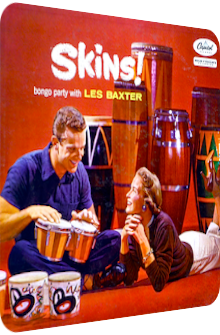
Les Baxter
Skins!
1957
Skins! by composer and arranger Les Baxter (1922–1996) is not only his most mercilessly stringent album ever, but a second foreshadowing artifact of an exciting shtick yet to unfold, namely the bongo craze with its gazillions of Afro-Bop LP’s and related works sporting the bold term Percussion in their titles. Released in 1957 on Capitol Records, Les Baxter sets yet another trend after single-handedly moulding the Exotica genre as an important adviser on both Yma Sumac’s debut Voice Of The Xtabay (1950) and his own exotic opus released a few months later, called Ritual Of The Savage (1951). Despite these two colorful efforts, with many more to follow from both artists, the continuation of the story is well-known: it was not until Martin Denny’s genre-constituting Exotica, recorded in December 1956, that Exotica was truly born by means of its genre name and escapism convention.
Skins! then proves to be another apex. The front artwork, while perfectly exquisite and rooted in Space-Age aesthetics, may be its only flaw, as crazy this may seem, for the majority of the ten unique arrangements are devoid of any melody. Instead, tribalism, ritualism, Paganism and other related -isms reign. The bongos are in the limelight – the subtitle is, after all, Bongo Party With Les Baxter – but there are also congas, boo-bams, djembes, timbales, classic drum kits, gongs, various shakers and other percussion instruments which embody 95% of the work, with the remaining sliver consisting of a piano, some alto flutes and a few chimes. Baxter does not try to deliver an insightful, truthful glimpse into tribal societies. He never did. Instead, Skins! is about transfigurations fueled by Baxter’s imagination. The album is not about facts, but factoids, would-be vignettes and alternative scenarios. The ten of them are dissected below.
Afro-Deesia turns the comfortable home of the listener into an African Steppe. The signature element of this tune is not necessarily found in the aural reticulation itself, but discernible via the intrinsic tendency of sounding strongly realistic. Crisp bongos and their counterparts in the shapes of aqueous driblets are underlined by gently shouting men, presumably chanting themsleves into a good-natured trance. The second phase of this tune introduces a change of pace, with a stronger flavor of California wafting through the air as cowbells prominently accompany the bongo blanket. For a Les Baxter song, Afro-Deesia is rather jejune and does not even interweave one picayune ornament. Brazilian Bash meanwhile feels like a real Baxter production, with a repeatedly beaten Chinese (!) gong opening the midtempo Samba cavalcades. Croaking guiros, clinging shakers and plinking cowbells gyrate around a delicately translucent and wonky piano melody which is much more memorable due to its quirky timbre than played melody. Short timpani eruptions add earth-shaking moments to this otherwise superbly glitzy-aeriform vignette.
Bustin’ The Bongos is next and the centerpiece of side A. With a runtime of over five minutes, it is one of the composer’s longer innovations. To be honest, I doubt that the duration does the song good, for it is strongly bucolic and less sophisticated. Cowbells and bongos mesh in order to form two different rhythms, one being laid-back and pointillistic, the other winding up the tribalism via ecstatically rapid-firing staccato bubbles. Nothing links to the legacy of Les Baxter, no chant is included, no other instrument dropped next to the cowbells and bongos. Exotica sans makeup. Conversation turns out to be more interesting, with ritualistic reeds similar to the sound of a blown coke bottle and bongo rivers conflating. The jumpiness, different frequencies and uplifting tempo altogether make this a much better percussion-only artifact, with the final song of side A Poppin’ Panderos being some kind of a retrospective. Uniting all previously featured characteristics – chants, different tempos, every instrument but the piano – in a coruscating capsule, this tune of two and a half minutes is greatly timed and literally runs on all cylinders by featuring an abundance of percussion prowess.
Talkin’ Drums launches side B in an almost too commonplace way. It unites a classic drum kit with bongos and cowbells, allowing the normative cymbals and hi-hats to function as remainders of the US-based production values. Clanging kettle drums round off the less exotic high-speed jam session. Reverberasia, on the other hand, is a revelation in the given endemic surroundings. Its ambience is mystical and blissful at the same time. The name implies a focus on the instruments’ reverb phases, and reverberation in all its complexions and calcined afterglows the listener shall receive. Pagan xylophone melodies echo into the distance, scrabbling guiros accompany the hypnotic melody, the gorgeous polyphony of the orchestra bells boosts the enchanting magic to otherworldly dimensions, and once the increasing voluminosity of these bells washes over the likeminded timbre of the cowbells, Skins! illumines the listener’s home with vivacious scintillae and glints. A superb addition!
Up next is Shoutin’ Drums, the next of kin to Talkin’ Drums. Keeping the listeners on his or her toes for almost six minutes, the balance between runtime and variety is again awkwardly twisted. Even worse, Baxter decides to inject another bold dose of Occidental characteristics. The bongos are perfectly exotic, all criticism aside, but the archetypically jazzy cymbals and sizzling gunmetal hi-hats as well as the spy theme-insinuating percussion placenta are denizens of a concrete jungle rather than the tropical opposite. Working its way towards a climax of furious military march-like mayhems, Shoutin’ Drums is both swinging and petrifying with its shock-and-awe physiognomy. Most impressive, but too long. Luckily, Gringo moves into the Tropics with prolonged “gringo” chants, raspy guiro saws and a potion of ever-twinkling cowbell fireflies below the bongo base, while the finale Mood Tattooed reunites an effervescent and shady harpsichord-piano hybrid with hyperventilating shakers, soothing bongos and conga apparitions. The surprisingly straightforward beat structure in the final third is admittedly easygoing, but enthralling in its own way, making Mood Tattooed a superb closer.
Neglecting fleshed out orchestras, euphonious hooks and even melodies in the classical sense most of the time, Les Baxter’s Skins! offers cohesive variety, a dichotomous – possibly oxymoronic – state that is nonetheless fully featured and omnipresent in the whole work. The textures are the kings on this release, eclecticism comes second, melodies are of minor importance. In 1957, Baxter’s album is pretty much a singular experience, but opens the gate for other artists due to its stellar sales and good reviews. Only one other work of the same year comes to mind that on the one hand relies on a tropical thicket completely constituted via percussion instruments and cheerful chants, and on the other hand emanates that exotic luminescence: Tito Puente’s Top Percussion, a gorgeous and unvarnished opus true to Latin genres and ways of life. Depending on a listener’s viewpoint, Les Baxter’s LP either outshines Señor Puente’s sparkler due to a more paradisal, innovative and chequered presentation or comes in second for this very reason, namely its diminished authenticity à la Hollywood.
Objectively, Skins! has more drums and yes, even more tone sequences in the classical sense. From the fleeting visit to the chant-accentuated Steppe in Afro-Deesia over the shrapnel frenzy in Talkin’ Drums to the wonderful iridescence of the dreamy Reverberasia, Les Baxter crosses the boundaries of genres, styles, countries and perceptions, creating a minimalistic work only in regard to the desiccated form of the melodies, but otherwise lets his work burst at the seams with shapeshifting patterns and wildly different surfaces. Needless to say that the sound quality is top notch. Skins! is not the sole reason for the existence of albums such as Don Ralke’s Bongo Madness (1957), let alone the one and only inspiration for highly melodious percussion albums akin to Terry Snyder‘s Persuasive Percussion (Volume 1 released in 1959), George Cates’ Polynesian Percussion, Irv Cottler’s All Around The World In Percussion or Stanley Black’s Exotic Percussion (all released 1961), but remains an important protuberance in the world of Exotica and a singular offering in Les Baxter’s discography. It is available on vinyl, CD, digital music stores and streaming services.
Exotica Review 393: Les Baxter – Skins! (1957). Originally published on Nov. 29, 2014 at AmbientExotica.com.
